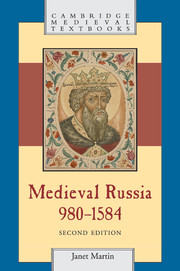Book contents
- Frontmatter
- Contents
- List of illustrations
- Acknowledgments
- Note on names, dates, and transliteration
- Chronology
- List of abbreviations
- 1 The era of Vladimir I
- 2 Princes and politics (1015–1125)
- 3 Kievan Rusˈ society
- 4 Kievan Rusˈ: the final century
- 5 The Golden Horde
- 6 The Russian lands within the Golden Horde
- 7 The Daniilovich ascension
- 8 The unification and centralization of Muscovy
- 9 Muscovite domestic consolidation
- 10 Foreign policy and foreign trade
- 11 Ivan IV the Terrible
- 12 Conclusions and controversies
- Select bibliography
- Index
- Cambridge Medieval Textbooks
5 - The Golden Horde
Published online by Cambridge University Press: 05 June 2012
- Frontmatter
- Contents
- List of illustrations
- Acknowledgments
- Note on names, dates, and transliteration
- Chronology
- List of abbreviations
- 1 The era of Vladimir I
- 2 Princes and politics (1015–1125)
- 3 Kievan Rusˈ society
- 4 Kievan Rusˈ: the final century
- 5 The Golden Horde
- 6 The Russian lands within the Golden Horde
- 7 The Daniilovich ascension
- 8 The unification and centralization of Muscovy
- 9 Muscovite domestic consolidation
- 10 Foreign policy and foreign trade
- 11 Ivan IV the Terrible
- 12 Conclusions and controversies
- Select bibliography
- Index
- Cambridge Medieval Textbooks
Summary
During the first decades of the thirteenth century, while the princes of Volynia, Chernigov, and Smolensk were disputing the throne of Kiev and the descendants of Vsevolod were concentrating their attention on their principality of Vladimir-Suzdal′, developments were occurring far to the east that would have significant consequences for the Riurikid princes and their peoples. A young Mongol chieftain named Temuchin was subordinating and uniting the Turkic and Mongolian tribes of Mongolia. In 1206 a quriltai or assembly of military and princely dignitaries from those tribes acclaimed Temuchin their great khan and began to organize what would become the Mongol Empire. By the time Chingis Khan, as Temuchin is known to posterity, died in 1227, he had launched an invasion of northern China (which began in 1211 and would continue to 1234) and extended his empire westward to incorporate the domain of the Khwarezm-shah in Central Asia; reconnaissance units of his armies had also explored the Caucasus Mountains and ventured into the steppe north of the Caspian Sea and south of the Rusˈ lands.
When Chingis Khan died, the lands of his empire were distributed among his heirs, the four sons of his first wife. In accordance with Mongol custom Chingis' own ulus, the Mongol “heartland,” was left to the youngest son Tolui. The third son, Ogedei, became the great khan. The second son, Chagatai, received Central Asia. And the westernmost lands beyond Chagatai's ulus and the Aral Sea were assigned to the eldest son, Juchi (Jochi).
- Type
- Chapter
- Information
- Medieval Russia, 980–1584 , pp. 149 - 174Publisher: Cambridge University PressPrint publication year: 2007

